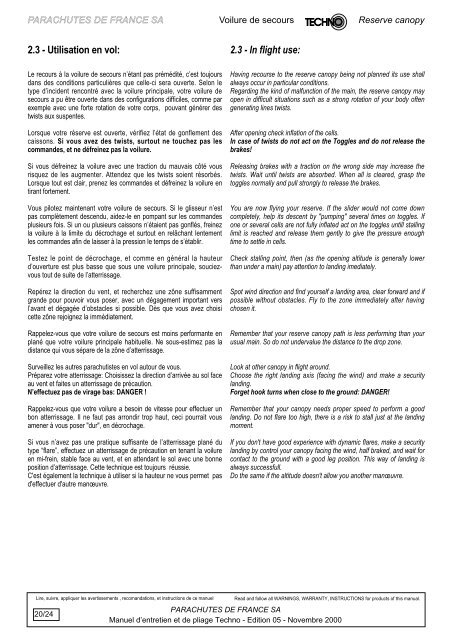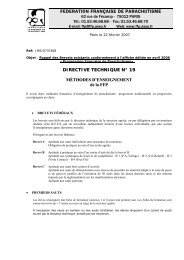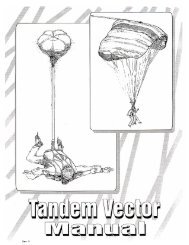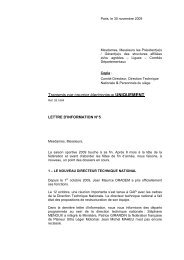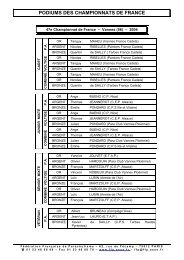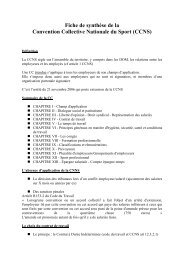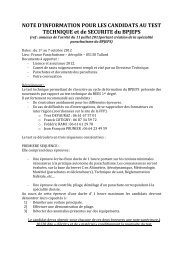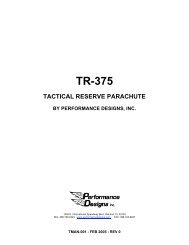Télécharger (PDF, 738KB) - Fédération Française de Parachutisme
Télécharger (PDF, 738KB) - Fédération Française de Parachutisme
Télécharger (PDF, 738KB) - Fédération Française de Parachutisme
You also want an ePaper? Increase the reach of your titles
YUMPU automatically turns print PDFs into web optimized ePapers that Google loves.
PARACHUTES DE FRANCE SA<br />
Voilure <strong>de</strong> secours<br />
Reserve canopy<br />
2.3 - Utilisation en vol:<br />
2.3 - In flight use:<br />
Le recours à la voilure <strong>de</strong> secours n’étant pas prémédité, c’est toujours<br />
dans <strong>de</strong>s conditions particulières que celle-ci sera ouverte. Selon le<br />
type d’inci<strong>de</strong>nt rencontré avec la voilure principale, votre voilure <strong>de</strong><br />
secours a pu être ouverte dans <strong>de</strong>s configurations difficiles, comme par<br />
exemple avec une forte rotation <strong>de</strong> votre corps, pouvant générer <strong>de</strong>s<br />
twists aux suspentes.<br />
Lorsque votre réserve est ouverte, vérifiez l’état <strong>de</strong> gonflement <strong>de</strong>s<br />
caissons. Si vous avez <strong>de</strong>s twists, surtout ne touchez pas les<br />
comman<strong>de</strong>s, et ne défreinez pas la voilure.<br />
Si vous défreinez la voilure avec une traction du mauvais côté vous<br />
risquez <strong>de</strong> les augmenter. Atten<strong>de</strong>z que les twists soient résorbés.<br />
Lorsque tout est clair, prenez les comman<strong>de</strong>s et défreinez la voilure en<br />
tirant fortement.<br />
Vous pilotez maintenant votre voilure <strong>de</strong> secours. Si le glisseur n’est<br />
pas complètement <strong>de</strong>scendu, ai<strong>de</strong>z-le en pompant sur les comman<strong>de</strong>s<br />
plusieurs fois. Si un ou plusieurs caissons n’étaient pas gonflés, freinez<br />
la voilure à la limite du décrochage et surtout en relâchant lentement<br />
les comman<strong>de</strong>s afin <strong>de</strong> laisser à la pression le temps <strong>de</strong> s’établir.<br />
Testez le point <strong>de</strong> décrochage, et comme en général la hauteur<br />
d’ouverture est plus basse que sous une voilure principale, souciezvous<br />
tout <strong>de</strong> suite <strong>de</strong> l’atterrissage.<br />
Repérez la direction du vent, et recherchez une zône suffisamment<br />
gran<strong>de</strong> pour pouvoir vous poser, avec un dégagement important vers<br />
l’avant et dégagée d’obstacles si possible. Dès que vous avez choisi<br />
cette zône rejoignez la immédiatement.<br />
Rappelez-vous que votre voilure <strong>de</strong> secours est moins performante en<br />
plané que votre voilure principale habituelle. Ne sous-estimez pas la<br />
distance qui vous sépare <strong>de</strong> la zône d’atterrissage.<br />
Surveillez les autres parachutistes en vol autour <strong>de</strong> vous.<br />
Préparez votre atterrissage: Choisissez la direction d’arrivée au sol face<br />
au vent et faites un atterrissage <strong>de</strong> précaution.<br />
N’effectuez pas <strong>de</strong> virage bas: DANGER !<br />
Rappelez-vous que votre voilure a besoin <strong>de</strong> vitesse pour effectuer un<br />
bon atterrissage. Il ne faut pas arrondir trop haut, ceci pourrait vous<br />
amener à vous poser "dur", en décrochage.<br />
Si vous n’avez pas une pratique suffisante <strong>de</strong> l’atterrissage plané du<br />
type “flare”, effectuez un atterrissage <strong>de</strong> précaution en tenant la voilure<br />
en mi-frein, stable face au vent, et en attendant le sol avec une bonne<br />
position d’atterrissage. Cette technique est toujours réussie.<br />
C'est également la technique à utiliser si la hauteur ne vous permet pas<br />
d'effectuer d'autre manœuvre.<br />
Having recourse to the reserve canopy being not planned its use shall<br />
always occur in particular conditions.<br />
Regarding the kind of malfunction of the main, the reserve canopy may<br />
open in difficult situations such as a strong rotation of your body often<br />
generating lines twists.<br />
After opening check inflation of the cells.<br />
In case of twists do not act on the Toggles and do not release the<br />
brakes!<br />
Releasing brakes with a traction on the wrong si<strong>de</strong> may increase the<br />
twists. Wait until twists are absorbed. When all is cleared, grasp the<br />
toggles normally and pull strongly to release the brakes.<br />
You are now flying your reserve. If the sli<strong>de</strong>r would not come down<br />
completely, help its <strong>de</strong>scent by "pumping" several times on toggles. If<br />
one or several cells are not fully inflated act on the toggles untill stalling<br />
limit is reached and release them gently to give the pressure enough<br />
time to settle in cells.<br />
Check stalling point, then (as the opening altitu<strong>de</strong> is generally lower<br />
than un<strong>de</strong>r a main) pay attention to landing imediately.<br />
Spot wind direction and find yourself a landing area, clear forward and if<br />
possible without obstacles. Fly to the zone immediately after having<br />
chosen it.<br />
Remember that your reserve canopy path is less performing than your<br />
usual main. So do not un<strong>de</strong>rvalue the distance to the drop zone.<br />
Look at other canopy in flight around.<br />
Choose the right landing axis (facing the wind) and make a security<br />
landing.<br />
Forget hook turns when close to the ground: DANGER!<br />
Remember that your canopy needs proper speed to perform a good<br />
landing. Do not flare too high, there is a risk to stall just at the landing<br />
moment.<br />
If you don't have good experience with dynamic flares, make a security<br />
landing by control your canopy facing the wind, half braked, and wait for<br />
contact to the ground with a good leg position. This way of landing is<br />
always successfull.<br />
Do the same if the altitu<strong>de</strong> doesn't allow you another manœuvre.<br />
Lire, suivre, appliquer les avertissements , recomandations, et instructions <strong>de</strong> ce manuel Read and follow all WARNINGS, WARRANTY, INSTRUCTIONS for products of this manual.<br />
PARACHUTES DE FRANCE SA<br />
20/24<br />
Manuel d’entretien et <strong>de</strong> pliage Techno - Edition 05 - Novembre 2000


